sociolinguistics
社会语言学名词
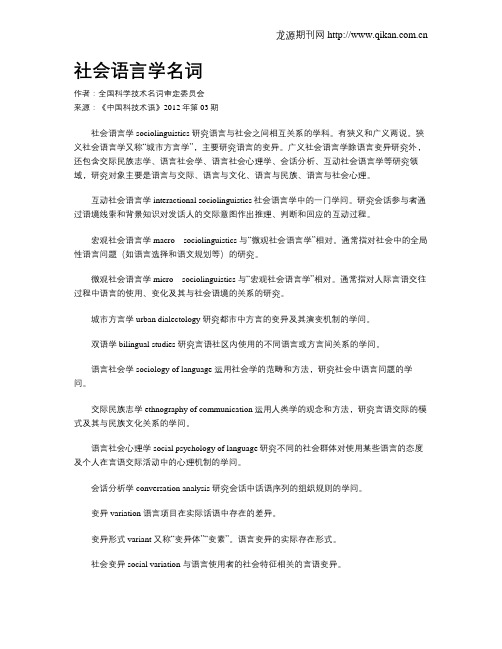
社会语言学名词作者:全国科学技术名词审定委员会来源:《中国科技术语》2012年第03期社会语言学 sociolinguistics 研究语言与社会之间相互关系的学科。
有狭义和广义两说。
狭义社会语言学又称“城市方言学”,主要研究语言的变异。
广义社会语言学除语言变异研究外,还包含交际民族志学、语言社会学、语言社会心理学、会话分析、互动社会语言学等研究领域,研究对象主要是语言与交际、语言与文化、语言与民族、语言与社会心理。
互动社会语言学 interactional sociolinguistics社会语言学中的一门学问。
研究会话参与者通过语境线索和背景知识对发话人的交际意图作出推理、判断和回应的互动过程。
宏观社会语言学 macro sociolinguistics 与“微观社会语言学”相对。
通常指对社会中的全局性语言问题(如语言选择和语文规划等)的研究。
微观社会语言学 micro sociolinguistics 与“宏观社会语言学”相对。
通常指对人际言语交往过程中语言的使用、变化及其与社会语境的关系的研究。
城市方言学 urban dialectology 研究都市中方言的变异及其演变机制的学问。
双语学 bilingual studies 研究言语社区内使用的不同语言或方言间关系的学问。
语言社会学 sociology of language 运用社会学的范畴和方法,研究社会中语言问题的学问。
交际民族志学 ethnography of communication运用人类学的观念和方法,研究言语交际的模式及其与民族文化关系的学问。
语言社会心理学 social psychology of language研究不同的社会群体对使用某些语言的态度及个人在言语交际活动中的心理机制的学问。
会话分析学 conversation analysis 研究会话中话语序列的组织规则的学问。
变异 variation 语言项目在实际话语中存在的差异。
超全sociolinguistics
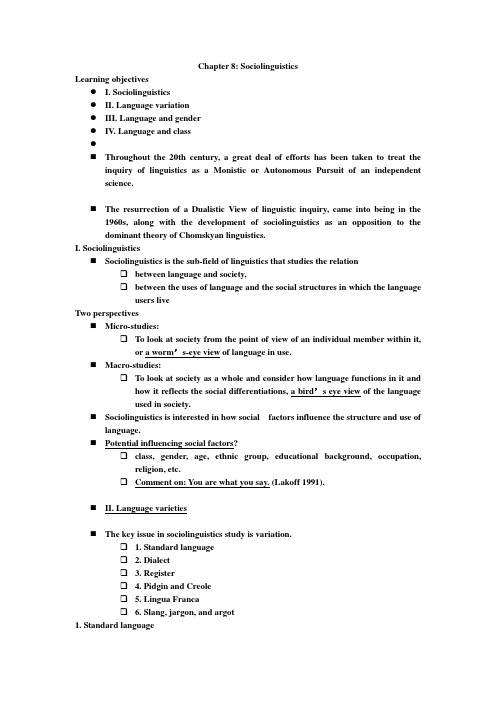
Chapter 8: SociolinguisticsLearning objectives●I. Sociolinguistics●II. Language variation●III. Language and gender●IV. Language and class●⏹Throughout the 20th century, a great deal of efforts has been taken to treat theinquiry of linguistics as a Monistic or Autonomous Pursuit of an independent science.⏹The resurrection of a Dualistic View of linguistic inquiry, came into being in the1960s, along with the development of sociolinguistics as an opposition to the dominant theory of Chomskyan linguistics.I. Sociolinguistics⏹Sociolinguistics is the sub-field of linguistics that studies the relation❑between language and society,❑between the uses of language and the social structures in which the language users liveTwo perspectives⏹Micro-studies:❑To look at society from the point of view of an individual member within it, or a worm’s-eye view of language in use.⏹Macro-studies:❑To look at society as a whole and consider how language functions in it and how it reflects the social differentiations, a bird’s eye view of the languageused in society.⏹Sociolinguistics is interested in how social factors influence the structure and use oflanguage.⏹Potential influencing social factors?❑class, gender, age, ethnic group, educational background, occupation, religion, etc.❑Comment on: You are what you say. (Lakoff 1991).⏹II. Language varieties⏹The key issue in sociolinguistics study is variation.❑ 1. Standard language❑ 2. Dialect❑ 3. Register❑ 4. Pidgin and Creole❑ 5. Lingua Franca❑ 6. Slang, jargon, and argot1. Standard language⏹George Bernard Shaw, Pygmalion⏹ A particular variety of a language is better than any other.⏹This dominant, or prestigious variety is often called standard variety orstandard language/dialect⏹Quote: A language is a dialect with an army and navy.⏹Question: what is the definition of the standard language in China?⏹普通话的定义:❑以北京语音为标准音, 以北方话为基础方言, 以典范的现代白话文著作为语法规范的现代汉民族共同语。
语言学复习资料

语言学复习资料下定义1.(P3)Sociolinguistics(社会语言学): The studies of all the social aspects of language and its relation with society is called sociolinguistics.2.(P7)Language(语言): Language is a system of arbitrary vocal symbols used for human communication.3.(P8)Arbitrariness(任意性): This means that there is no logical connection between meanings and sounds.4.(P2)Phonetics(语音学):Phonetic refers to the study of sounds used in linguistic communication.5.(P16)Voicing(浊音化): Vibration of the vocal cords results in a quality of speech sounds.6.(P26)Assimilation rule(同化规则): The assimilation rule assimilates one sound to another by “copying” a feature of a sequential phoneme, thus making the two phones similar.7.(P29)Intonation(语调): When pitch, stress and sound length are tied to the sentence rather than the word in isolation, they are collectively known as intonation.8.(P42)Syntax(句法): Syntax is a branch of linguistics that studies the rules that govern the formation of sentences.9.(P42)Category(范畴): Category refers to a group of linguistic items which fulfill the same or similar functions in a particular language such as a sentence, a noun phrase or a verb.10.(P48)Complementizers(补语化成分):Words which introduce the sentence complement are termed complementizers.11.(P53)Head movement(中心语移动): The movement of a word from the head position in one phrase into the head positionin another is known as head movement.12.(P64-65)Linguistic context(语言语境): The linguistic context is concerned with the probability of a word’s co-occurrence or collocation with another word.13.(P66)Reference(所指): Reference means what a linguistic form refers to in the real, physical world.14.(P70)Relational opposites(关系反义词): Pairs of words that exhibit the reversal of a relationship between the two items are called relational opposites.15.(P74)Argument(论元): An argument is a logical participant in a predication, largely identical with a nominal element in a sentence.16.(P77)Pragmatics(语用学): Pragmatics is the study of how speakers of a language use sentences to effect successful communication.17.(P81)Constatives(表述句): Constatives are statements that either state or describe, and are thus verifiable.填空题第一章1. (P3) If a linguistic aims to describe and analyze the language people actually use, it is said to be descriptive(描写性的). If the linguistic study aims to lay down rules for “correct and standard” behavior in using language, it is said to be prescriptive(规定性的).2.(P4) The description of a language at some point of time in history is a synchronic(共时的)study; the description of a language as it changes through time isa diachronic(历时的)study.3.(P4) Langue(语言)refers to the abstract linguistic system shared by all the members of a speech community, and parole(言语)refers to the realization of language in actual use4. (P5) Chomsky defines competence(语言能力)as the ideal user’s knowledge of the rules of his language, and performance (语言表现)the actual realization of his knowledge in linguistic communication.第二章5.(P17)As some speech sounds produced differ only in some detailed aspects, the IPA provides its users with another set of symbols called diacritics(发音符号/辨音符)6. (P23) A phoneme(音素)is a phonological unit, it is a unit that is of distinctive value, it is an abstract value.7. (P24) It can be easily observed that phonetically similar sounds might be related in two ways. If they are two distinctive phonemes,they are said to form a phonemic contrast(音素对照),e.g. /p/ and /b/ in [pit] and [bit].8. (P24)When two different forms are identical in every way except for one sound segment which occur the same position in the strings, the two sound combinations are said to from a minimal pair(最小配对).e.g pill and bill, pill and till are a minimal pair.9.(P25) Rules that govern the combination of sounds in a particular language, the rules are called sequential rules(序列规则).10.(P27) The phonemic features that occur above the level of the segments are called suprasegmental feature(超音段特征).第三章11.(P33)Morpheme(词素): the smallest unit of language that carries information about meaning or function.A morpheme which can be a word by itself is called a free morpheme(自由词素). Whereas a morpheme that must beattached to another one is called bound morpheme(粘着词素).12.(P33) The variant forms of a morpheme are called its allomorphs(词素变体).第四章13. (P44) Syntactic units that are built around a certain word category are called phrases(短语), the category of which is determined by the word category around which the phrase is built.14. (P45)Phrases that are formed of more than one word usually contain the following elements: head(中心语), specifier(标志语)and complement(补语).15. (P48)The information about a word’s complement is included in the head andtermed subcategorization(次范畴化).16. (P52) Transformation(转换)is a special type of rule that can move an element from one position to another.第五章17. (P67-68)Synonymy:近义关系的分类:1) Dialectal synonyms(方言同义词)-- synonyms used in different regional dialects.(来自不同地域的人使用同一种语言产生的不同)2) Stylistic synonyms(文体同义词) -- synonyms differing in style3) Synonyms that differ in their emotive or evaluative(评价) meaning4) Collocational synonyms(搭配同义)5) Semantically different synonyms(不考)18.(P69) When two words are identical in sound, they are homophones(同音不同形不同义). When two words are identical in spelling, they are homographs(同形不同音不同义). When twowords are identical in both sound and spelling, they are complete homonyms(同形同音不同义).19. (P70) Antonymy:反义关系的分类1) Gradable antonyms(可分等级的反义词)2) Complementary antonyms(互补反义词)3) Relational opposites(关系反义词)20.(P72) Componential analysis(成分分析)is a way proposed by the structural semanticists to analyze word meaning. The approach is based upon the belief that the meaning of a word can be dissected into meaning components, called semantic features.第六章21. (P81)Three Speech Acts:三种言语行为According to Austin new model, a speaker might be performing three acts simultaneously when speaking:locutionary act(言内行为), illocutionary act(言外行为), and perlocutionary act(言后行为).22.(P90)Pragmatic failure(语用失误) occurs when the speaker fails to use language effectively to achieve a specific communicative purpose, or when the hearer fails to recognize the intention or the illocutionary(言外之意) force of the speaker’s utterance in the context of c ommunication.第八章23.(P111) Speech variety(言语变体), or language variety, refers to any distinguishable form of speech used by a speaker or a group of speakers.24. (P117) Halliday further distinguishes three social variables(语域三变量)that determine the register: field of discourse(语场), tenor of discourse(语旨), and mode of discourse(语式).25. (P122) The term diglossia(双言制度) refers to a sociolinguistic situation similar to bilingualism where two varieties of a language exist side by side throughout the community, with each having a definite role to play.上一页下一页。
社会语言学简介
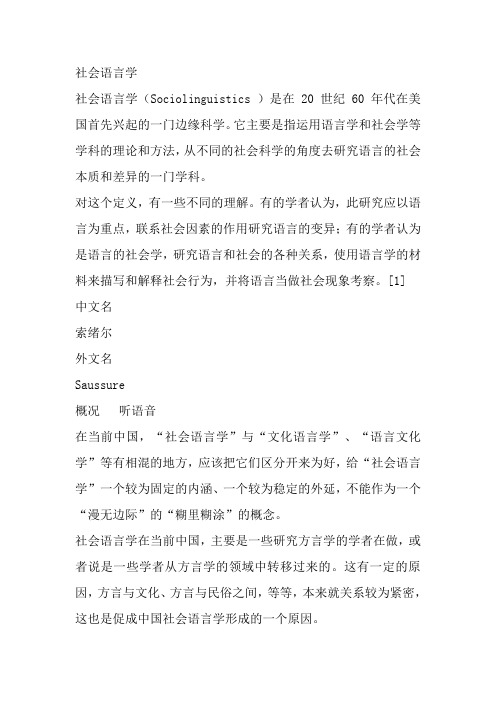
社会语言学社会语言学(Sociolinguistics )是在 20 世纪 60 年代在美国首先兴起的一门边缘科学。
它主要是指运用语言学和社会学等学科的理论和方法,从不同的社会科学的角度去研究语言的社会本质和差异的一门学科。
对这个定义,有一些不同的理解。
有的学者认为,此研究应以语言为重点,联系社会因素的作用研究语言的变异;有的学者认为是语言的社会学,研究语言和社会的各种关系,使用语言学的材料来描写和解释社会行为,并将语言当做社会现象考察。
[1]中文名索绪尔外文名Saussure概况听语音在当前中国,“社会语言学”与“文化语言学”、“语言文化学”等有相混的地方,应该把它们区分开来为好,给“社会语言学”一个较为固定的内涵、一个较为稳定的外延,不能作为一个“漫无边际”的“糊里糊涂”的概念。
社会语言学在当前中国,主要是一些研究方言学的学者在做,或者说是一些学者从方言学的领域中转移过来的。
这有一定的原因,方言与文化、方言与民俗之间,等等,本来就关系较为紧密,这也是促成中国社会语言学形成的一个原因。
社会语言学将从以下两个领域进行探索:第一,是社会生活的变化将引起语言(诸因素)的变化,其中包括社会语境的变化对语言要素的影响。
第二,从语言(诸因素)的变化探究社会(诸因素)的变化。
在第一个领域中,社会是第一性,社会有了变化,才引起语言的变化。
在第二个领域中社会仍是第一性,但未会有像语言相对论者所认为,有什么模式的语言就会产生什么样的社会模式或者社会文化。
社会语言学的任务是在于描述“语言和社会结构的共变”。
“共变”是现代语言学常用的新术语。
该命题说的“共变”是现代语言学常用的新术语。
该命题说的“共变”似乎指语言是一个变数。
这两个变数互相影响,互相作用,互相制约,互相接触而引起的互相变化。
[2]代表人物听语音索绪尔索绪尔(Saussure,1857-1913)首先提出社会语言学的研究方向。
他认为Language分为两个方面:一是语言(Langue)即平时人们研究的语言系统或是总结语言的使用,例如语法,句法,词法等;另一个方面便是言语(Parole),即社会语言学,语言的当代的使用偏好,与当代社会相关联的研究方向。
sociolinguistics
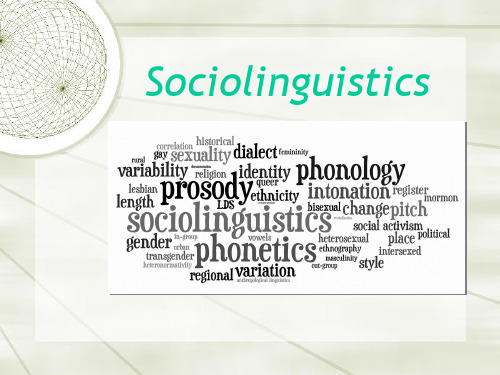
3.2 The Study Scopes of Sociolinguistics
社会语言学的研究范围:一般而言,包括以下几个方面: 1)一个国家或地区的语言状况如双言制(diglossia) 、双语、多语或多方言状况; 2)各种语言变体包括地域方言和社会方言(social dialect或sociolect)、标准语和土语(vernacular) 、正式语体(formal style)和非正式语体(informal style)等构造特点及其社会功能; 3)交谈情景与选择语码之间的关系以及语码选择与人 际关系的相互作用; 4)社会以及不同的集团对各种语言或语言变体的评价 和态度以及由此产生的社会效应; 5)由于社会的、文化的、经济的、政治的种种原因以 及语言接触所引起的语言变化的方式和规律,等等。
empirical investigation.
It is related to methodology and contents of social sciences.
2. DEVELOPMENT AND MAIN REPRESENTATIVES
ORIGINS: Saussure’s & Chomsky’s concepts PROMINENT FIGURES: William Labov & Peter Trudgill
(3). It also studies the influence of the essence and differentiations of society on language (e.g. How to distinguish a person‟s status in his social class by groups, religion, gender, educational level, age, ethnic origin, etc. which he belongs to.) On the whole, sociolinguistics, drawing upon the theories and methods of different aspects of social sciences( such as sociology, anthropology, ethnography, psychology, geography, history, etc.), studies and researches language, and its social essence and differentiations, as well as its social factors.
Sociolinguistics
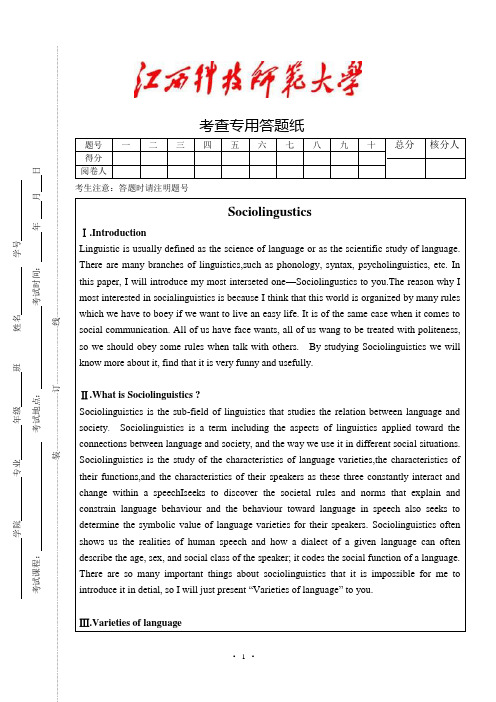
题号
一
二
三
四
五
六
七
八
九
十
总分
核分人
得分
阅卷ngustics
Ⅰ.Introduction
Linguistic is usually defined as the science of language or as the scientific study of language. There are many branches of linguistics,such as phonology, syntax, psycholinguistics, etc. In this paper, I will introduce my most interseted one—Sociolingustics to you.The reason why I most interested in socialinguistics is because I think that this world is organized by many rules which we have to boey if we want to live an easy life. It is of the same case when it comes to social communication. All of us have face wants, all of us wang to be treated with politeness, so we should obey some rules when talk with others.By studying Sociolinguistics we will know more about it, find that it is very funny and usefully.
Sociolinguistics
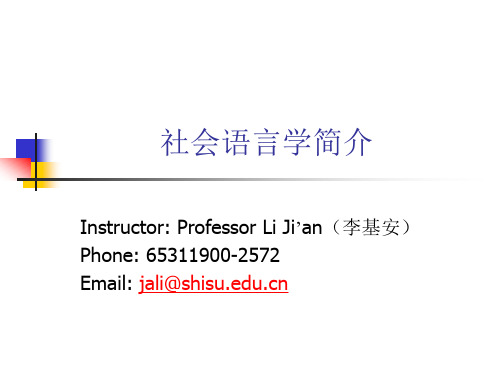
引言
社会语言学是一门年轻的学科,从确立 至今只有 40年左右的历史,但却因其独 特的学科性质和极强的发展能力而备受 关注。 社会语言学的确立以1964年在美国召开 的第9届国际语言学大会为标志。
历史背景
考察语言问题需结合社会因素的思想在 中西学术史中早已有之。 但直到18、19世纪、语言的社会性质才 真正引起人们的重视。有关语言和社会 关系的论述开始出现在一些著名学者的 文章、著作中。
主要流派
社会方言学(social dialectology) 语言社会学(sociology of language) 交际民族志学(ethnopology of communication) 语言社会心理学(social psychology of language) 互动社会语言学(interactional sociolinguistics)
而且成为许多大学语言学系的专业课程, 得到了学术界的普遍承认。
历史背景
就连当初把社会语言学研究比喻为采集蝴蝶标 本的工作,认为其重要性无法同理论语言学相 提并论的乔姆斯基,最后也改变了看法,声称 从不怀疑社会语言学研究在语言科学中的合法 地位。 当代社会语言学的应用研究在法律、广告、诊 断、教育等领域内广泛开展,已经成为社会文 化的有机组成部分之一,引起了越来越多的关 注。
主要流派
互动社会语言学(interactional sociolinguistics)
曾被译为“交际社会语言学”或“相互交往社 会语言学” 会话过程绝不是一个简单的罗列词语的过程。 研究语言和非语言知识在会话过程中的作用以 及说话人的社会文化背景如何跟这些知识相互 影响。
语言学流派
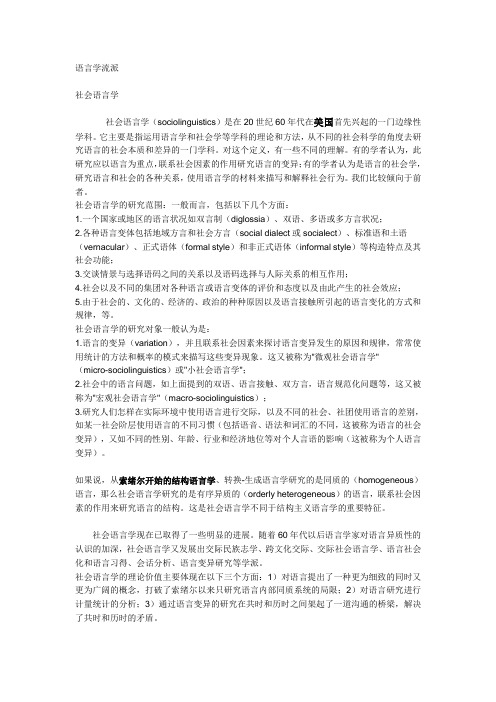
语言学流派社会语言学社会语言学(sociolinguistics)是在20世纪60年代在美国首先兴起的一门边缘性学科。
它主要是指运用语言学和社会学等学科的理论和方法,从不同的社会科学的角度去研究语言的社会本质和差异的一门学科。
对这个定义,有一些不同的理解。
有的学者认为,此研究应以语言为重点,联系社会因素的作用研究语言的变异;有的学者认为是语言的社会学,研究语言和社会的各种关系,使用语言学的材料来描写和解释社会行为。
我们比较倾向于前者。
社会语言学的研究范围:一般而言,包括以下几个方面:1.一个国家或地区的语言状况如双言制(diglossia)、双语、多语或多方言状况;2.各种语言变体包括地域方言和社会方言(social dialect或socialect)、标准语和土语(vernacular)、正式语体(formal style)和非正式语体(informal style)等构造特点及其社会功能;3.交谈情景与选择语码之间的关系以及语码选择与人际关系的相互作用;4.社会以及不同的集团对各种语言或语言变体的评价和态度以及由此产生的社会效应;5.由于社会的、文化的、经济的、政治的种种原因以及语言接触所引起的语言变化的方式和规律,等。
社会语言学的研究对象一般认为是:1.语言的变异(variation),并且联系社会因素来探讨语言变异发生的原因和规律,常常使用统计的方法和概率的模式来描写这些变异现象。
这又被称为"微观社会语言学"(micro-sociolinguistics)或"小社会语言学";2.社会中的语言问题,如上面提到的双语、语言接触、双方言,语言规范化问题等,这又被称为"宏观社会语言学"(macro-sociolinguistics);3.研究人们怎样在实际环境中使用语言进行交际,以及不同的社会、社团使用语言的差别,如某一社会阶层使用语言的不同习惯(包括语音、语法和词汇的不同,这被称为语言的社会变异),又如不同的性别、年龄、行业和经济地位等对个人言语的影响(这被称为个人语言变异)。
英语语言学概论第八章笔记

英语语言学概论第八章笔记Chapter 8 Socio-linguistics 社会语言学1.What is socio-linguistics? 什么是社会语言学?Sociolinguistics is the sub-discipline of linguistics that studies language in social contexts.社会语言学是语言学的一个分支,它研究社会环境中的语言。
nguage variation 语言变异a)S peech community 言语社区In sociolinguistic studies, speakers are treated as members of social groups. The social group isolated for any given study is called speech community. A speech community thus defined as a group of people who form a community (which may have as few members as a family or as many member as a country), and share the same language or a particular variety of language. The important characteristic of a speech community is that the members of the group must, in some reasonable way, interact linguistically with other members of the community. They may share closely related language varieties, as well as attitudes toward linguistic norms.社会语言学研究中,说话者被当作是社会群体的成员。
SOCIOLINGUISTICS(1)

3.What are the outstanding features of sociolinguistics?
Features of sociolinguistics:
a. It has been a very important new branch of linguistics. b. It has been a recognized part of most courses at university level on linguistics or language. c. It is one of the main growth points in the study of language, from the point of both teaching and research.
1.2 What are the main factors that
led to the growth of sociolinguistics?
The term sociolinguistics was first used by Haver C. Currie in 1952. However it is generally recognized that sociolinguistics as a independent discipline arose in the middle of 1960s. In 1960 a number of scholars involved in the study of language and culture of India produced a volume called Linguistic Diversity in South Asia. The first conference on sociolinguistics was held in May 1964 in the U.S.A. What are the main factors leading to the growth of sociolinguistics? A. The general recognition of the importance of the fact that language is a very variable phenomenon and that this variability may have as much to do with society as with language. B. The demand made by the development of modern sciences and society and the financial support given by some capitalist governments such as the U.S. government. C. The healthy climate for its growth created by the development of disciplines like sociology, anthropology and psychology as it takes concepts and findings from them.
sociolinguistics
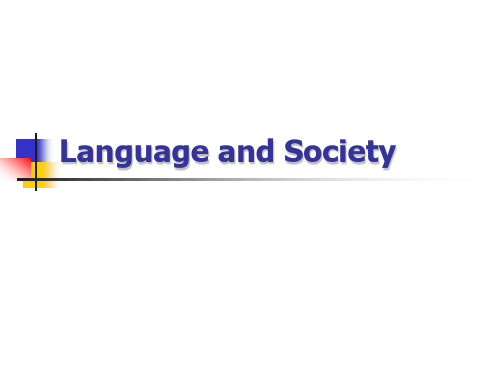
educational level and type of education, age, sex, ethnic origin, etc.
5
What is Sociolinguistics?
SEMANTICS PRAGMATICS SOCIOLINGUISTICS
INFORMATION = PROPOSITION
Looking at socof an individual member within it.
12
Varieties of language 语言的变体
Dialectal varieties方言变体 Register语域 Degree of formality 正式的程度
For example, in the southwest of England and in the American Midwest, many speakers use an /r/ sound in words like her, four, but speakers from London region and New England don’t.
21
Register 语域
linguistic repertoire (言语库)
The language or language varieties that a person knows and uses within his or her speech community in everyday communication. (一个人所掌握的所有语言变体) 一个人所掌握的所有语言变体)
16
Dialectal varieties方言变体
4. Language and age语言与年龄 语言与年龄 The difference may come from the changing of society, social attitudes and value judgments.
社会语言学

游汝杰、邹嘉彦 指出社会语言学(Sociolinguistics)学科名称是由社会学(Sociology)和语言学(Linguistics)复合而成,内容包括两个方面,一是Social Linguistics,基本涵义是:从语言的社会属性出发,用社会学的方法研究语言,从社会的角度解释语言变体和语言演变。二是Sociology of Language,基本涵义是:从语言变体和语言演变的事实,来解释相关的社会现象及其演变和发展的过程。 从研究方向来界定社会语言学,简而言之,前者是从社会研究语言,后者是从语言研究社会。
祝畹瑾
祝畹瑾 她将研究内容细分为五个方面:(1)一个国家或地区的语言状况,和按照各种属性划分的言语共同体使用语言的状况和特征;(2)各种语言变体的构造特点及其社会功能;(3)交谈的情景与选择语码之间的关系以及语码选择与人际关系的相互作用;(4)社会以及不同的集团对各种语言变体的评价和态度以及由此产生的社会效应;(5)由于社会的、文化的、经济的政治的种种原因以及语言接触所引起的语言变化的方式和规律等。 她的界定主要是关注言语共同体、语言变体、语码转换、社会与变体的联系这几个方面。
Sociolinguistics is an umbrella term which covers a variety of different interests in language and society,including the social functions of language and the social characteristics of its users.Sociolinguistics is the studyguage varieties,the characteristics of their functions,and the characteristics of their speakers as these three constantly interact and change within a speechIseeks to discover the societal rules and norms that explain and constrain language behaviour and the behaviour toward language in speech also seeks to determine the symbolic value of language varieties for their speakers.That language varieties come to have symbolic or symptomatic value,in and of themselves,is an inevitable consequence of their functional differentiation.(Reproduction of this article without written permission is strictly prohibited.contact me via email if you want to copy this eassay: This essay is taken from"Linguistics.A Course Book" Editor in chief:胡壮麟Subeditor:姜望琪 资料来源:《语言学教程》 主编:胡壮麟 副主编:姜望琪)
语言学讲义 考研 7 Sociolinguistics
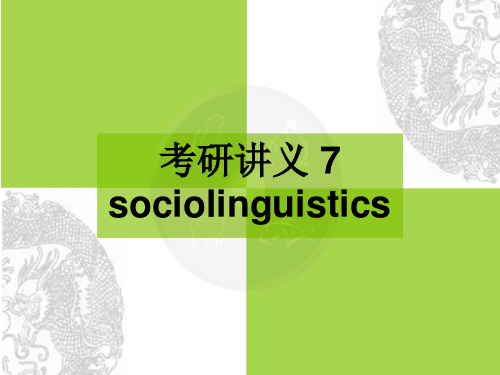
• J. R. Firth (1890-1960): theory of the context of situation
1. The relevant features of the participants, persons, personalities. 2. The relevant objects. 3. The effects of the verbal action.
• The social environment can also be reflected in language, and can often have an effect on the structure and the vocabulary.
– For example, a society's kinship system is generally reflected in its kinship vocabulary.
6
• Anthropological study of linguistics: study of language in a sociocultural context. • Bronislaw Malinowski (18841942):
1.The meaning of a word greatly depends upon its occurrence in a given context. nguage functions as a link in human activity, a mode of action.
11
• Linguistic evidence of cultural differences
– Terms of address
Sociolinguistics(6)
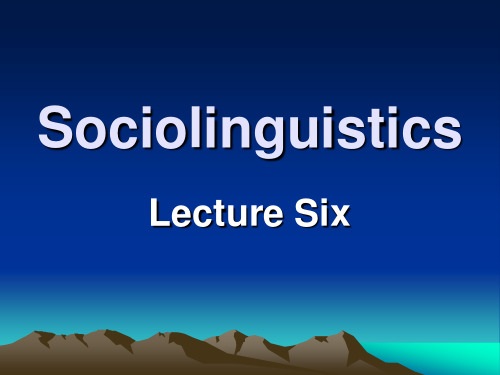
• It is clear that there are many such constraints, which may differ from society to society.
• For example, in Britain we are required to respond when someone else greets us;
Sociolinguistics
Lecture Six
Speech as Social Interaction
1. What is ‘speech’? 2. Is ‘speech’ social or individual?
3. What do social constrains mean?
4. What are the main perspectives to look at social constratrumentalities’ refers to the choice of channel, e.g., oral, written, or telegraphic, and to the actual forms of speech employed, such as the language, dialect, code, or register that is chosen.
• For example:
• A two-person conversation involves a speaker and hearer whose roles change;
• a ‘dressing down’ involves a speaker and hearer with no role change;
• It is hardly necessary to stress the general importance of speech in social life. Speech allows us to communicate with each other at a much more sophisticated level than would otherwise be possible, and since communication is a social activity it could be said that speech is also social.
chapter 8 sociolinguistics 英语专业语言学PPT

Language varieties are related to region, social ass, educational background, and the degree of formality of a situation in which language is used, including standard language, dialects, registers, pidgins, creoles, etc.
Horizontal bilingualism (横向性双语现 象) & diagonal bilingualism (倾斜性 双语现象)
Multilingualism
A situation where 3 or more languages are used by an individual or by a group of speakers.
Chapter 8 Sociolinguistics
Language is a city to the building of which every human being brought a stone. ——Ralph Waldo Emerson
Once you open your mouth, you are placed. —— Pygmalion by Bernard Shaw
The origin of the name
➢ -- Hebrew pidjom meaning “trade or exchange” -- Chinese characters pei and ts'in meaning “paying money”
语言学讲义 考研 7 Sociolinguistics

• Users of the same language in a sense all speak differently. What each of them chooses to use is in part determined by one’s social background.
– When we speak we cannot avoid giving our listeners clues about our origin and our background.
– 肥皂剧、卡通、布丁、苹果派、雀巢、巴士、 排挡、耐克、因特网、KTV、EMAIL – Typhoon, gongfu, etc.
15
Netspeak 网络语言
• • • • • • • • • • 顶(支持) 555(呜呜呜) ding(顶) mm/MM(妹妹) LZ(楼主) DD/dd(弟弟) 88(拜拜) 偶(我) 马甲(ID) ID • • • • • • • • • • 斑竹(版主) 恩(嗯) 汗或寒(敬畏) 晕(非常惊异) ps/PS(photoshop的简称) 灌水(发帖子) ddd(顶顶顶) bs/BS(鄙视) 楼猪(楼主) 滴(的、地) 16
9
• Sapir-Whorf Hypothesis
– Edward Sapir (1884 - 1939) and Benjamin Lee Whorf (1897-1941)
• Our language helps mould our way of thinking and, consequently, different languages may probably express speakers’ unique ways of understanding the world.
sociolinguistics (1)
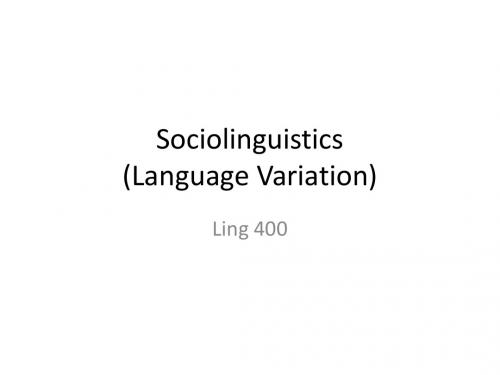
Case study (Japanese)
• There are some interesting socio-semantic facts that should be of interest to you. I will discuss some of them.
Sociolinguistics and Semantics
Pronouns and address terms Japanese has many first and second pronouns, but when they are used (esp. 2nd person pronouns), you have to be very careful. You usually avoid them. (It is hard not to be rude.) 1st: gender neutral: watakushi, watashi male: boku, ore, oira, washi (obsolete) female: atashi, uchi (Kyoto dialect?) 2nd: an(a)ta, omae, kimi, kisama, NAME-san, NAMEkun, NAME-tyan, kisama (archaic and rude) kisama ‘honorable person’ can only be used when you are ready to fight.
Sociolinguistics and Semantics
Pronouns and address terms 3rd: kare ‘he’, kanozyo ‘she’, ano-hito ‘that person’, ano-ko ‘that child’ ‘that girl’ kare ‘he’ and kanozyo ‘she’ were introduced only recently Name-san can be used in sentences (e.g. questions) addressed to this person. So it is indeed like a second person pronoun. E.g. Does Mr. Tanaka like sushi? This can mean ‘Mr. Tanaka, do you like sushi?’ in Japanese.
sociolinguistics

SOCIOLINGUISTICSThis introduction to some exciting aspects in the field of sociallinguistics is designed to encourage you to read further. There are many fascinating and odd phenomena that occur in the social aspects oflanguage.WHAT IS SOCIOLINGUISTICS?Sociolinguistics is a term including the aspects of linguisticsapplied toward the connections between language and society, and the waywe use it in different social situations. It ranges from the study of thewide variety of dialects across a given region down to the analysis betweenthe way men and women speak to one another. Sociolinguistics often showsus the humorous realities of human speech and how a dialect of a givenlanguage can often describe the age, sex, and social class of the speaker;it codes the social function of a language.Social FactorsINTRODUCTIONWhen two people speak with one another, there is always more going on than just conveying a message. The language used by the participants is always influenced by a number of social factors which define the relationship between the participants. Consider, for example, a professor making a simple request of a student to close a classroom door to shut off the noise from the corridor. There are a number of ways this request can be made:a.Politely, in a moderate tone "Could you please close the door?"b.In a confused manner while shaking his/her head "Why aren't you shutting the door?"c.Shouting and pointing, "SHUT THE DOOR!"The most appropriate utterance for the situation would be a. The most inappropriate would be c. This statement humiliates the student, and provides no effort by the professor to respect him/her. Utterance b is awkward because itimplies that the teacher automatically assumes that the student should know better than to leave the door open when there is noise in the hallway. The inappropriateness is a social decision tied to the social factors which shape the relationship between speaker ( the professor), and the listener (the student).When choosing an appropriate utterance for the situation, there are factors that you must consider in order to effectively convey the message to the other participant.1.Participants- how well do they know each other?2.Social setting- formal or informal3.Who is talking- status relationship/social roles ( student vs. professor)4.Aim or purpose of conversation5.TopicDo you notice that there is a difference in the way you speak to your friends and the way you speak to your relatives, teachers, or others of professional status?When telling your friend that you like his/her shirt, you say:"Hey, cool shirt, I like that!"When telling the President of the company your parents work for that you like his/her shirt, you say:"You look very nice today, I really like that shirt."This is called choosing your variety or code. This can also be seen on a larger scale, diglossia, where multilingual nations include a variety of accents, language styles, dialects and languages. Each of these factors is a reflection of the region and socio-economics background from which you come from. In monolingual societies, the region and socio-economic factors are determined by dialect and language style.It is not uncommon in our nation to see that languages other than English are spoken inside the home with friends and family. However when these bilingual or even trilingual families interact socially outside of their home, they will communicate in English. Even church services may use a variation of the language, one that you would only hear in side the church or in school. An example of the difference in the use of a language can be seen in the following example from Janet Holmes, "An Introduction to Sociolinguistics," of the two main languages used in Paraguay; Spanish and Guarani:Domain Addressee Setting Topic LanguageFamily Parent Home Planning a party GuaraniFriendship Friend Cafe Humorous ancedote GuaraniReligion Priest Church Choosing the Sunday liturgy SpanishEducation Teacher Primary Telling a story GuaraniEducation Lecturer University Solving math problem SpanishAdministration Official Office Getting an important license SpanishDiglossiaDiglossia: In a bilingual community, in which two languages or dialects are used differently according to different social situations.Janet Holmes defines diglossia as having three crucial features:1.In the same language, used in the same community, there are two distinct varieties. One is regardedas high (H) and the other low (L).2.Each is used for distinct functions.3.No one uses the high (H) in everyday conversation.In the following example it is easy to tell which variety you will use given the social situations:∙Telling a joke∙Interviewing for a job∙Giving a speech for a charity event∙Giving a speech for a friend for his/her birthday∙Church∙CafeteriaPIDGINS AND CREOLESINTRODUCTIONCan you guess what language this is?These lines are taken from a famous comic strip in Papua New Guinea: "Saposyukaikaiplantipinat, baiyukamap strong olsem phantom.""Fantom, yuprentrubilong mi. Inapyu ken helpim mi nau?""Fantom, em i go we?"Translation:'If you eat plenty of peanuts, you will come up strong like the phantom.''Phantom, you are a true friend of mine. Are you able to help me now?'1Where did he go?'A simplified language derived from two or more languages is called a pidgin. It is a contact language developed and used by people who do not share a common language in a given geographical area. It is used in a limited way and the structure is very simplistic. Since they serve a single simplistic purpose, they usually die out. However, if the pidgin is used long enough, it begins to evolve into a more rich language with a more complex structure and richer vocabulary. Once the pidgin has evolved and has acquired native speakers ( the children learn the pidgin as their first language), it is then called a Creole. An example of this is the Creole above from Papua New Guinea, TokPisin, which has become a National language.Reasons for the development of PidginsIn the nineteenth century, when slaves from Africa were brought over to North America to work on the plantations, they were separated from the people of their community and mixed with people of various other communities, therefore they were unable to communicate with each other. The strategy behind this was so they couldn't come up with a plot to escape back to their land. Therefore, in order to finally communicate with their peers on the plantations, and with their bosses, they needed to form a language in which they could communicate. Pidgins also arose because of colonization. Prominent languages such as French, Spanish, Portuguese, English, and Dutch were the languages of the colonizers. They traveled, and set up ports in coastal towns where shipping and trading routes were accessible.There is always a dominant language which contributes most of the vocabulary of the pidgin, this is called the superstrate language. The superstrate language from the Papua New Guinea Creole example above is English. The other minority languages that contribute to the pidgin are calledthe substrate languages.In the United States, there is a very well known Creole, Louisiana Creole, which is derived from French and African Languages. You most likely have heard of "Cajun" which is a developed dialect of this Creole.Can you guess what major language (the superstrate) contributed to the vocabulary in each of these Creoles? This table is taken from Janet Holmes, " An Introduction to Sociolinguistics":a. mopeastesabananb. de bin aldelukdat big tric. awaka go a wosud. olmaan i kas-imcheke. lipotesa bay mof. jafruherwirbleibeng. dis smol swain i bin go fomaket I am buying the bananathey always looked for a big tree he walked homethe old man is cashing a check he brought that for meYes at first we remainedthis little pig went to marketClick HERE for answers!ANSWERS:a.French based Seychelles Creoleb.English based Roper River Creolec.English based Sarand.English based Cape York Creolee.French based Guyanaisf.German based Papua New Guinea Pidgin Germang.English based Cameroon Pidgin POLITENESSIn everyday conversation, there are ways to go about getting the things we want. When we are with a group of friends, we can say to them, "Go get me that plate!", or "Shut-up!" However, when we aresurrounded by a group of adults at a formal function, in which our parents are attending, we must say, "Could you please pass me that plate, if you don't mind?" and "I'm sorry, I don't mean to interrupt, but I am not able to hear the speaker in the front of the room." I different social situations, we are obligated to adjust our use of words to fit the occasion. It would seem socially unacceptable if the phrases above were reversed.According to Brown and Levinson, politeness strategies are developed in order to save the hearers' "face." Face refers to the respect that an individual has for him or herself, and maintaining that "self-esteem" in public or in private situations. Usually you try to avoid embarrassing the other person, or making them feel uncomfortable. Face Threatening Acts (FTA's) are acts that infringe on the hearers' need to maintain his/her self esteem, and be respected. Politeness strategies are developed for the main purpose of dealing with these FTA's. What would you do if you saw a cup of pens on your teacher's desk, and you wanted to use one, would youa.say, "Ooh, I want to use one of those!"b.say, "So, is it O.K. if I use one of those pens?"c.say, "I'm sorry to bother you but, I just wanted to ask you ifI could use one of those pens?"d.Indirectly say, "Hmm, I sure could use a blue pen right now."There are four types of politeness strategies, described by Brown and Levinson, that sum up human "politeness" behavior: Bald On Record, Negative Politeness, Positive Politeness, andOff-Record-indirect strategy.If you answered A, you used what is called the Bald On-Record strategy which provides no effort to minimize threats to your teachers' "face."If you answered B, you used the Positive Politeness strategy. In this situation you recognize that your teacher has a desire to be respected. It also confirms that the relationship is friendly and expresses group reciprocity.If you answered C, you used the Negative Politeness strategy which similar to Positive Politeness in that you recognize that they want to be respected however, you also assume that you are in some way imposing on them. Some other examples would be to say, "I don't wantto bother you but..." or "I was wondering if ..."If you answered D, you used Off-Record indirect strategies. The main purpose is to take some of the pressure off of you. You are trying not to directly impose by asking for a pen. Instead you would rather it be offered to you once the teacher realizes you need one, and you are looking to find one. A great example of this strategy is something that almost everyone has done or will do when you have, on purpose,decided not to return someone's phone call, therefore you say, " I tried to call a hundred times, but there was never any answer."Politeness and GenderAre Women More Polite Than Men?Politeness is defined by the concern for the feelings of others.From Nancy Bonvillain's "Language, Culture, andCommunication" she notes that, "women typically use more polite speech than do men, characterized by a high frequency of honorific (showing respect for the person to whom you are talking to, formal stylistic markers), and softening devices such as hedges and questions."Sociolinguists try to explain why there is a greater frequency of the use of polite speech from women than from men. In our society it is socially acceptable for a man to be forward and direct his assertiveness to control the actions of others. However, society has devalued these speech patterns when it is utilized by women. From historical recurrence, it has appeared that women have had a secondary role in society relative to that of the male. Therefore, it has been (historically) expected from a women to "act like a lady" and "respect those around you." It reflects the role of the inferior status being expected to respect the superior. In Frank and Anshen's "Language and the Sexes", they note that boys, "are permitted, even encouraged, to talk rough, cultivate a deep "masculine" voice and, if they violate the norms of correct usage or of polite speech, well "boys will be boys," although, peculiarly, it is much less common that "girls will be girls" Fortunately, these roles are becoming more of a stereotypeand less of a reality. However, the trend of expected polite speech from the female continues to remain. This is a prime example of how society plays an important part on the social function of the language.Honorifics: linguistic markers that signal respect to the person you are speaking to:"Hey ma, fix my jacket"Mom, could you please do me a favor, and fix my jacket?"In Japanese, according to Masa-aki Yamanashi, the appropriate choice of honorifics is based on complex rules evaluating addressee, referent, and entities or activities associated with either. Example taken from Nancy Bonvillain's "Language, Culture, and Communication."1. Without Honorific.yamadagamusuko to syokuzi o tanosindayamada son dinner enjoyed"Yamada enjoyed dinner with his son."2. With Honorific.yamada-san gamusuko-san to o-syokuzi o tanosim-are-tayamada-HON son-HON HON-dinner enjoyed-HON"Yamada enjoyed dinner with his son."Hedges: "loosely speaking", having a sense of "fuzziness" they take away assertiveness in your statements, soften the impact of your words or phrases such as " I was sort-of-wondering," "maybe if....,""I think that....""HANK is SO MEAN!"vs." I sort-of-think that Hank is a bit of a mean person."More Gender Speech IssuesWho Talks More, Men or Women?A common cultural stereotype describes women as being talkative, always speaking and expressing their feelings. Well, this is probably true, however, do women do it more than men? No! In fact an experiment designed to measure the amount of speech produced suggested that men are more prone to use up more talking time than women. An experiment b y Marjorie Swacker entailed using three pictures by a fifteenth century Flemish artist, Albrecht Durer which were presented to men and women separately. They were told to take as much time as they wanted to describe the pictures. The average time for males: 13.0 minutes, and the average time for women 3.17 minutes.Why is this?Sociolinguists try to make the connection between our society and our language in a way that suggests that women talk less because it has not always been as culturally acceptable as it has been for men. Men have tended to take on a more dominant role not only in the household, but in the business world. This ever-changing concept is becoming le ss applicable in our society, however, the trend is still prominent in some societies across the world. It is more acceptable for a man to be talkative, carry on long conversation, or a give a long wordy speech, however it is less acceptable for a women to do so. It has been more of a historical trend for men have more rights to talk. However , it is common for men to be more silent in situations that require them to express emotion. Since childhood, they have been told to "keep their cool" and "remain calm, be a man."Do Men and Women Really Speak Differently?Can you tell who, most likely, is speaking?"Wow what a beautiful home!""That outfit looks lovely on you!""Nice coat.""Where can I find a pair of shoes like that, I like them.""This is a super cool shirt, I love it.""This shirt is cool."Sometimes comment like these may be extremely stereotypical, however it is easy for any one to identify who the speaker is. In English we laugh at these utterances, however in some languages there are gender-exclusive speech patterns for men and womenrespectively. It is not uncommon to see these speech patterns cross-culturally to linguistically the gender of the speaker. Edward Sapir documented such occurrences in Yana, an American Indian language, where there are distinct words that are used for men and women respectively.Example taken from Janet Holmes, "An Introduction to Sociolinguistics"Womenba yaa Menba-nayaa-na"dear""person"Sapir found that the male form of speech is used by men when talking to other men. Female speech is used by women talking to other women or men, or by men talking to women. Therefore, there is an exclusive speech pattern for men speaking to men.There are also some examples of this in Japanese.Example taken from Nancy Bonvillain's, "Language, Culture, and Communication"Womenohiya onaka oisii taberu Menmizuharaumaikuu"water""stomach""delicious""eat"。
- 1、下载文档前请自行甄别文档内容的完整性,平台不提供额外的编辑、内容补充、找答案等附加服务。
- 2、"仅部分预览"的文档,不可在线预览部分如存在完整性等问题,可反馈申请退款(可完整预览的文档不适用该条件!)。
- 3、如文档侵犯您的权益,请联系客服反馈,我们会尽快为您处理(人工客服工作时间:9:00-18:30)。
• One of the principal uses of language is to communicate meaning, but it is also used to establish and to maintain social relationships. • It is the second function of language use that sociolinguists study.
• Regional/geographical dialects: • Varieties of a language spoken in a geographical area, such as Cockney dialect, and Yorkshire dialect in Britain, or North Midland dialect and South Midland dialect in the United States, and Guangdong dialect in China.
• Sociolects and standard dialects are often confused because they are interpreted only in terms of prestige. • In due course the sociolect with the highest status in a country often acquires the status of the standard dialect.
• A regional dialect is a variation of language different enough to be classed as a separate entity, but not different enough to be classed as a separate language. • Sometimes a dialect rises in status and becomes the standard variety of a country, becoming standard dialect, e.g. standard English, standard Chinese.
• Like other varieties of English, black English has its own features at the phonological, morphological, syntactic, and lexical level. • Simplification of consonant clusters at the end of a word (consonant deletion rule). • The final-position consonants are often deleted (passed [pa:s], mend [men], desk [des], and told [təul ] • A syntactic feature is the deletion of ‘be’ as in “They mine”, “You crazy”, “Her hands cold”, and “That house big”. • Copula verb deletion. (some other dialects of English and in languages such as Russian and Chinese)
• Another syntactic feature is the use of double negation constructions. • He don’t know nothing. • I ain’t afraid of no ghosts. • Such double negation constructions were found in all dialects of English of the earlier periods.
• Regional variation is speech variation that is geographically divided (according to the particular area where the speaker comes from). • The most distinguishable linguistic feature in the regional variation is accent.
Definition and the Goal
• Sociolinguistics is the field that studies the relation between language and society, between the uses of language and the social structures in which the users of language live. • It is a field of study that assumes that human society is made up of many related patterns and behaviours, some of which are linguistic.
• Ethic dialect: • A social dialect of a language that cuts across regional differences; it is mainly spoken by a less privileged population that has experienced some form of social isolation such as racial discrimination or segregation. • Black English is the kind of English spoken mostly by a large section of non-middleclass American Blacks.
• Accent and Dialect • Accent is the manner of pronunciation that identify where a speaker is from, in contrast to dialect, e.g. New York accent. • Dialect is a variety of a language with the combinational features of grammar, vocabulary, and pronunciation.
• No two speakers speak exactly the same way. • Each speaker has certain characteristic features of his own in the way of speaking. • “Shakespeare’s language” or “Lu Xun’s language”
Register
• Language varies with the user but it also varies with the situations under which it is used, i.e. the social context. • A register is the type of language which is selected as appropriate to the type of situation. • Three social variables determine the register: field of discourse, tenor of discourse, and mode of discourse.
sociolinguistics
• • • • • • • •
Contents: 1.Definition and Goal. nguage varieties. Dialectal varieties Register 3.Standard and Nonstandard Dialect 4.Pidgin and Creole 5.Bilingualism and Diglossia
• The goal of sociolinguistics is to explore the nature of language variation and language use.
Language variation
• Language use varies regionally, socially, stylistically, temporally, individually.
• Social dialects or sociolects: • Varieties of a language used by people belonging to particular social classes. • Since members of a speech community bind themselves together in groups for gains, security, amusement, or solidarity, they tend to use the same kind of language which is highly stratified in terms of social division, such as class, professional status, age and sex.
• Idiolects: • Varieties of a language used by individual speakers, with peculiarities of pronunciation, grammar, and vocabulary. • Each individual in a speech community speaks in a characteristically individual way and makes special choice of words to express his thoughts.
